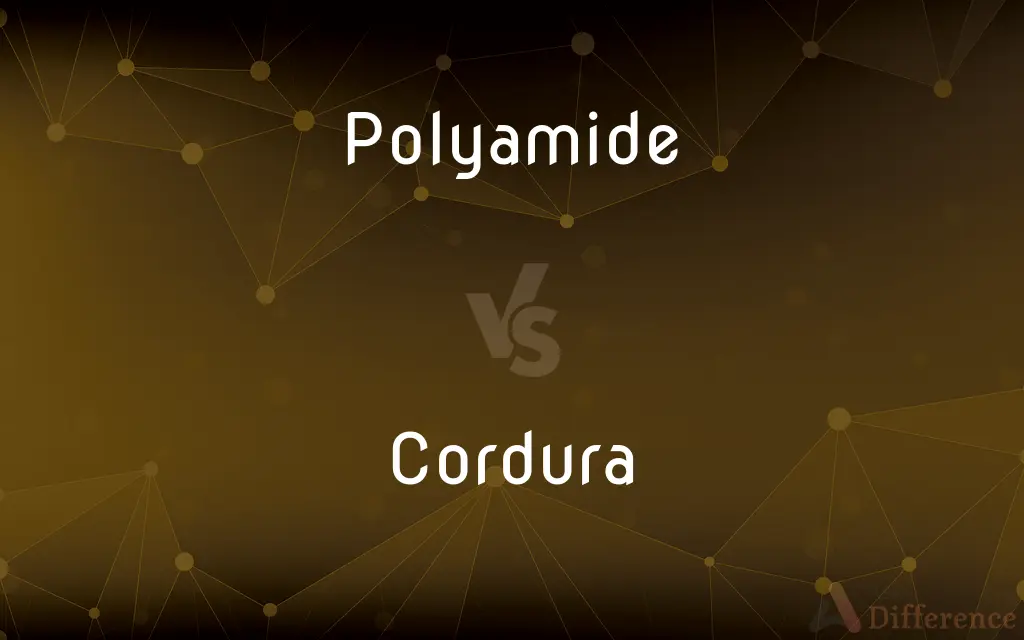Polyamide vs. Cordura — What's the Difference?
By Urooj Arif & Maham Liaqat — Updated on April 2, 2024
Polyamide is a type of synthetic polymer known for strength and durability, used in fabrics and plastics. Cordura, a brand of polyamide fabrics, is renowned for resistance to abrasions and tears, highlighting material vs. branded product distinction.

Difference Between Polyamide and Cordura
Table of Contents
ADVERTISEMENT
Key Differences
Polyamide is a category of synthetic polymers, made from repeating units linked by amide bonds, widely used in creating fibers for textiles and various plastics. Its characteristics include high resistance to wear and tear, making it suitable for a broad range of applications, from clothing to automotive parts. On the other hand, Cordura is a specific brand of polyamide fabric, developed and trademarked by Invista, known for its durability and resistance to abrasions, tears, and scuffs. It is specifically engineered for use in products requiring high durability, such as military wear, outdoor gear, and workwear.
While polyamides, in general, are appreciated for their mechanical strength and elasticity, Cordura stands out for its exceptional durability and is often used in high-performance gear. The distinction lies not just in the physical properties but also in the application scope; polyamide serves as a broad category of materials, whereas Cordura targets niche markets that demand extreme durability.
The production of polyamide involves the polymerization of specific monomers, resulting in a wide variety of polyamide types, each with unique properties. Cordura, though a type of polyamide, undergoes additional processing and treatment to enhance its resistance to external stresses, signifying a specialized production process that imbues the fabric with its renowned toughness.
Polyamides have revolutionized the textile and plastics industries by offering materials that combine flexibility with resilience. Cordura fabric, leveraging the inherent qualities of polyamide, pushes these advantages further, focusing on products exposed to harsh conditions and heavy usage. Thus, while all Cordura fabrics are polyamides, not all polyamides meet the rigorous standards to be branded as Cordura.
The significance of choosing between polyamide and Cordura depends largely on the application. For everyday items where general durability is sufficient, polyamide materials are cost-effective and perform well. However, for outdoor equipment, military gear, and other demanding applications, Cordura provides the added assurance of longevity and resistance to extreme wear.
ADVERTISEMENT
Comparison Chart
Type
Synthetic polymer category.
Brand of high-performance polyamide fabric.
Key Properties
Strength, elasticity, wear resistance.
Enhanced durability, abrasion, and tear resistance.
Applications
Textiles, automotive parts, packaging.
Military wear, outdoor gear, workwear.
Production
Polymerization of monomers.
Specialized processing of polyamide fibers.
Market
Broad, general use.
Niche markets requiring high durability.
Durability
High, varies by type.
Exceptionally high, designed for extreme conditions.
Branding
Generic term for material.
Trademarked, associated with specific quality.
Compare with Definitions
Polyamide
Durability.
Polyamide fibers are chosen for car tires due to their strength.
Cordura
Brand of Polyamide Fabric.
Cordura is a preferred material for heavy-duty backpacks.
Polyamide
Synthetic Polymer.
Nylon, a type of polyamide, is widely used in clothing and ropes.
Cordura
Abrasion Resistance.
Cordura fabrics are used in motorcycle apparel for their resistance to road abrasions.
Polyamide
Flexibility.
Polyamide can be spun into fine threads for textiles or molded for plastic components.
Cordura
High Durability.
Military uniforms often use Cordura for its longevity in harsh conditions.
Polyamide
Thermal Resistance.
Polyamide parts are utilized in engines for their ability to withstand high temperatures.
Cordura
Tear Resistance.
Workwear made from Cordura offers enhanced protection against tearing.
Polyamide
Wear Resistance.
Polyamide fabrics are used in sportswear for their durability.
Cordura
Specialized Use.
Outdoor tents made of Cordura fabric withstand extreme weather conditions.
Polyamide
A polyamide is a polymer with repeating units linked by amide bonds.Polyamides occur both naturally and artificially. Examples of naturally occurring polyamides are proteins, such as wool and silk.
Cordura
Cordura is a collection of synthetic fiber-based fabric technologies used in a wide array of products including luggage, backpacks, trousers, military wear and performance apparel.Originally developed and registered as a trademark by E.I. du Pont de Nemours and Company (DuPont) in 1929, it is now the property of Invista, a fully owned subsidiary of Koch Industries. Cordura fabrics are usually made of nylon, but can be a blend of nylon with cotton or other natural fibers.
Polyamide
A synthetic polymer of a type made by the linkage of an amino group of one molecule and a carboxylic acid group of another, including many synthetic fibres such as nylon.
Polyamide
A polymer containing repeated amide groups, as in various kinds of nylon.
Polyamide
(chemistry) Any of a range of polymers containing amide (or peptide) repeat units; examples include proteins and nylon.
Polyamide
A polymer containing repeated amide groups
Common Curiosities
Are polyamide materials environmentally friendly?
The environmental impact of polyamides can vary; while they are durable and long-lasting, their synthetic nature and production process raise concerns about sustainability and recyclability.
Why is Cordura considered superior for outdoor and military gear?
Cordura fabrics are specifically engineered for high durability, offering exceptional resistance to abrasions, tears, and scuffs, which is critical in outdoor and military applications.
Can all polyamides be used in textiles?
While many polyamides are suitable for textiles due to their strength and flexibility, not all have the desired properties for specific textile applications.
What distinguishes Cordura from other polyamide fabrics?
Cordura is distinguished by its specialized processing techniques that enhance its durability and resistance to harsh conditions, beyond the inherent properties of standard polyamides.
Can Cordura be used in fashion?
Yes, while known for durability, Cordura is also used in fashion for stylish yet functional clothing and accessories.
Is Cordura waterproof?
Cordura itself is highly resistant to moisture; however, waterproofing depends on the specific treatment of the fabric during manufacturing.
How does the cost of Cordura compare to other polyamide fabrics?
Cordura, due to its specialized manufacturing process and superior durability, typically comes at a higher cost compared to standard polyamide fabrics.
Can Cordura be recycled?
Like other polyamides, recycling Cordura is possible, but the process can be complex and depends on the recycling facilities available.
How do the thermal properties of polyamides benefit industrial applications?
Polyamides' resistance to high temperatures makes them ideal for components in machines and vehicles that are exposed to heat.
How do care and maintenance of polyamide and Cordura fabrics differ?
Both require specific care to maintain their durability and performance, but Cordura may need more specialized attention due to its unique properties.
What future innovations are expected in polyamide and Cordura materials?
Ongoing research focuses on enhancing their environmental friendliness, performance under extreme conditions, and recyclability.
What makes polyamide materials so versatile?
Polyamides' molecular structure gives them a balance of strength, elasticity, and resistance to chemicals and wear, making them suitable for a wide range of applications.
What role does the weave of a fabric play in its properties, like in Cordura?
The weave affects the fabric's strength, durability, and texture; tighter weaves in Cordura enhance its resistance to wear and tear.
Are there different types of Cordura?
Yes, Cordura comes in various types, each designed for specific applications, such as lightweight fabrics for clothing or rugged materials for heavy-duty gear.
Share Your Discovery

Previous Comparison
Blur vs. Fade
Next Comparison
Core vs. LoreAuthor Spotlight
Written by
Urooj ArifUrooj is a skilled content writer at Ask Difference, known for her exceptional ability to simplify complex topics into engaging and informative content. With a passion for research and a flair for clear, concise writing, she consistently delivers articles that resonate with our diverse audience.
Co-written by
Maham Liaqat













































